
| Installation and Administration | Getting Started | Command Line | Configuration | Eclipse Plugin | Reference Manual |
| Show on single page Show on multiple pages |

|
|
|
With the introduction milestones in your project, Squore offers new ways to measure your objectives and detect deviations from your goals early. Milestones are a series of goals for specific metrics at certain dates in the life of your project and add the following to your process management:
You are alerted early if your current performance shows that you will not meet your goals and can react before it is too late
You keep track of your various goals and communicate any change to the rest of your team
You can reflect on a project's history and learn from it
This example focuses on a project that is slipping, and shows how the team reacts along the course of the development process. Our team is tracking several objectives around issue management, technical debt and self-descriptiveness over the lifetime of the project, which includes milestones for 5 sprints labelled SPRINT1 to SPRINT5.
Here is where they stand in the fourth sprint and try to assess whether they will meet their Technical Debt objective for the release date at the end of Sprint 5:
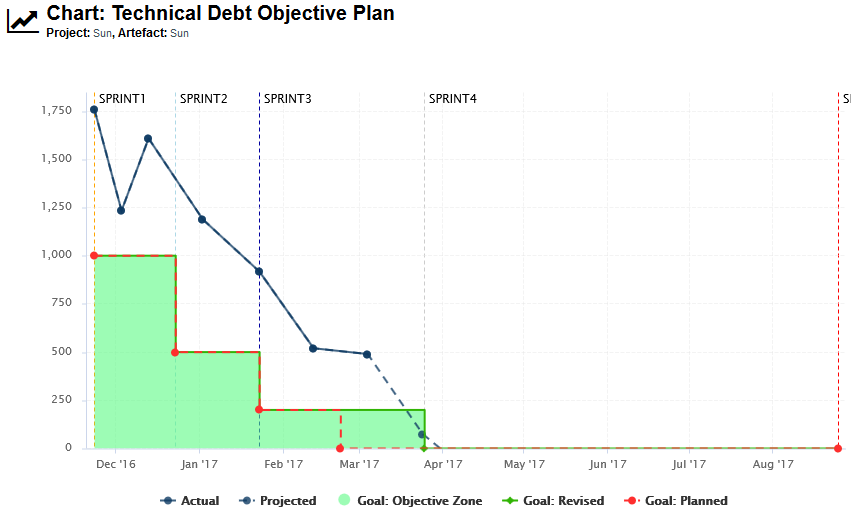
The chart shows the following information:
Vertical dotted lines (markers) on the x-axis for each milestone in the project at the predefined date
A solid dark-blue line showing the technical debt value for each version of the project so far
A dotted dark-blue line showing estimations for technical debt for future versions absed on the progress so far
A dotted red line showing the goals set at the beginning of the project for each sprint for the technical debt metric
A solid green line showing the goals as they were revised as time went on (the date for Sprint 4 was moved back).
A turquoise area highlighting the acceptable range for the tehnical debt for each sprint, making it clear that the technical debt has never been under control so far, but that projections show that the goal should be met by the end of Sprint 3
In order to understand why changes were made to the goals, let's go back to V4 and look at the Technical Debt Objective Plan again. The end of Sprint4 still has its original date, and projections aready show that technical debt will not be under control by the end of the sprint.
Our chart is configured to show the projected value for the next 5 analyses (based on the rate of previous analyses), and the firth projection meeting the expectations for SPRINT4 appear well after the original date for SPRINT4.
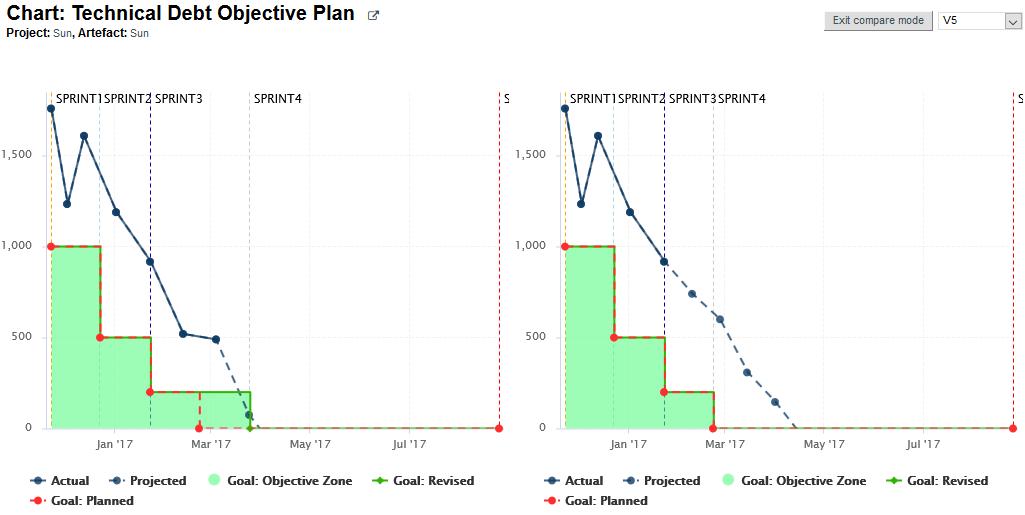
The team knew this at the time: a Objective alert for Technical Debt action item was opened on as early as V3 to inform them that the current performance could cause problems for their objective set 50 days later.
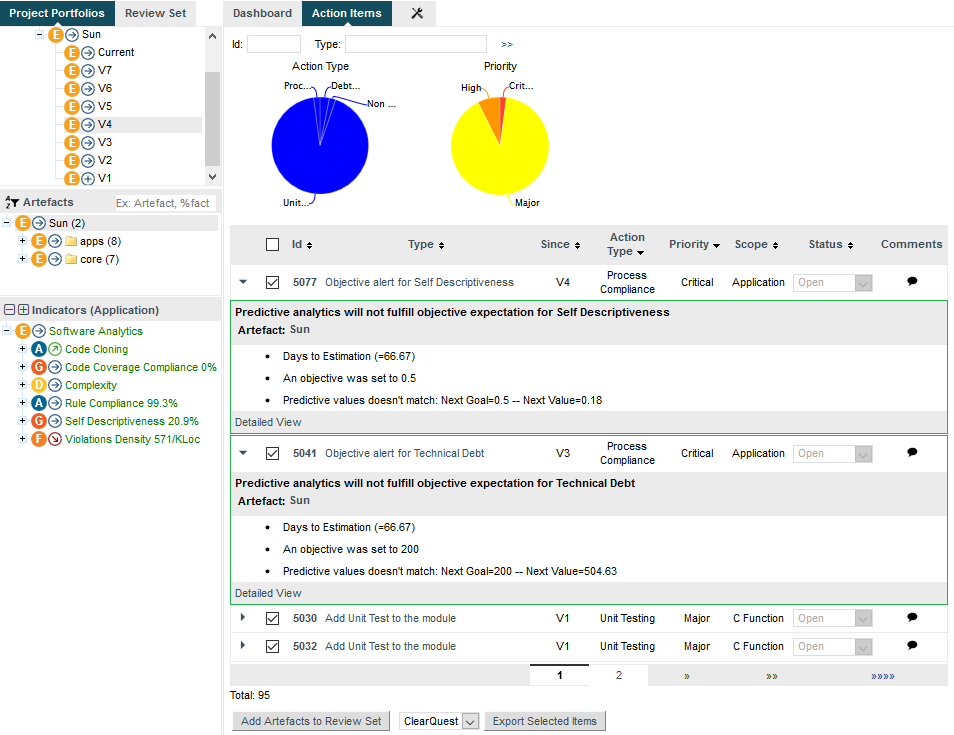
After a team meeting, it is decided that the best course of action is to keep the goal for the SPRINT4 milestone, but move its date back by one month. The next analysis confirms this on the Technical Debt Objective plan chart, where you see the first deviation between the planned goal (red) and the actual goal (green). The progress objective will be now met:
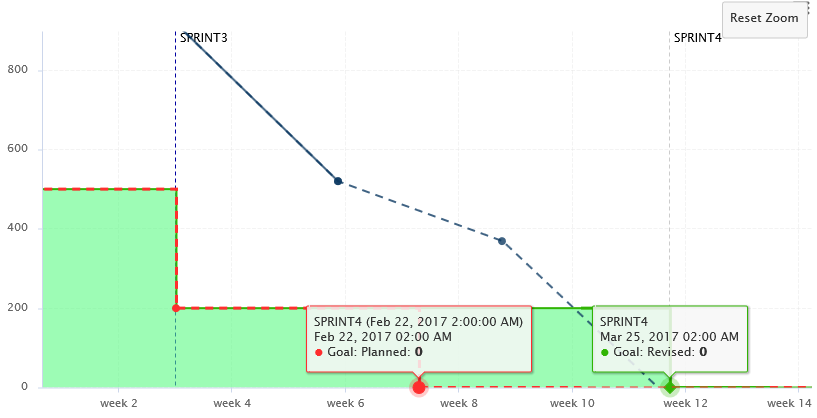
In order to add support for milestones to your model, configure your wizard to allow users to create milestones and goals:
<Bundle xmlns:xi="http://www.w3.org/2001/XInclude"> <wizard wizardId="ANALYTICS" versionPattern="v#N1#" img="../../Shared/Wizards/squore_logo.png" hideRulesEdition="FALSE"> <milestones canCreateMilestone="TRUE" canCreateGoal="TRUE"> <goals displayableFamilies="ANALYTICS_GOALS" /> </milestones> </wizard> </Bundle>
The
milestones
element allows users to create milestones in
the project wizard (canCreateMilestone="TRUE") and also set goals (canCreateGoal="TRUE").
The goals can be set for metrics of the GOALS family only in this example (displayableFamilies="ANALYTICS_GOALS").
The result in the web UI is the following:
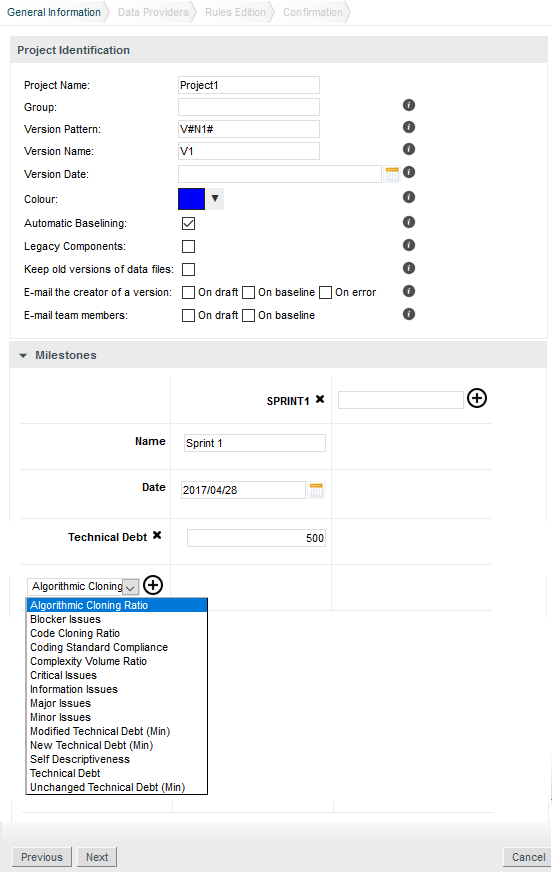
A wizard allowing users to create milestones freely during an analysis
When creating a new project, a user decides to create a Sprint 1 milestone with one objective of 500 for the Technical Debt indicator. Other goals can be set, for the other metrics in the project that belong to the ANALYTICS_GOALS family listed in the dropdown list at the bottom of the table.
If you have company-wide milestones and objectives that need to be set for every project created with the wizard, you can specify the goals directly. Milestones can also be marked as mandatory or optional:
<Bundle xmlns:xi="http://www.w3.org/2001/XInclude"> <wizard wizardId="ANALYTICS_WITH_MILESTONES" versionPattern="v#N1#" img="../../Shared/Wizards/squore_logo.png" hideRulesEdition="FALSE"> <milestones canCreateMilestone="TRUE" canCreateGoal="TRUE"> <goals displayableFamilies="GOALS"> <goal measureId="TECH_DEBT" mandatory="TRUE" highestIsBest="FALSE" /> <goal measureId="ISSUE_BLOCKER" mandatory="TRUE" highestIsBest="TRUE" /> <goal measureId="ISSUE_CRITICAL" mandatory="TRUE" highestIsBest="TRUE" /> <goal measureId="ROKR_SUBSET" mandatory="TRUE" highestIsBest="FALSE" /> </goals> <milestone id="REQUIREMENT_FREEZE" mandatory="TRUE"> <defaultGoal measureId="TECH_DEBT" value="0" /> <defaultGoal measureId="ISSUE_BLOCKER" value="1" /> <defaultGoal measureId="ISSUE_CRITICAL" value="30" /> <defaultGoal measureId="ROKR_SUBSET" value="1" /> </milestone> <milestone id="INFRASTRUCTURE_FREEZE" mandatory="TRUE"> <defaultGoal measureId="TECH_DEBT" value="0" /> <defaultGoal measureId="ISSUE_BLOCKER" value="1" /> <defaultGoal measureId="ISSUE_CRITICAL" value="50" /> <defaultGoal measureId="ROKR_SUBSET" value="1" /> </milestone> <milestone id="CODE_FREEZE" mandatory="TRUE"> <defaultGoal measureId="TECH_DEBT" value="0" /> <defaultGoal measureId="ISSUE_BLOCKER" value="1" /> <defaultGoal measureId="ISSUE_CRITICAL" value="90" /> <defaultGoal measureId="ROKR_SUBSET" value="0.5" /> </milestone> <milestone id="BETA_RELEASE" mandatory="FALSE"> <defaultGoal measureId="TECH_DEBT" value="1" /> <defaultGoal measureId="ISSUE_BLOCKER" value="1" /> <defaultGoal measureId="ISSUE_CRITICAL" value="95" /> <defaultGoal measureId="ROKR_SUBSET" value="0.3" /> </milestone> <milestone id="RELEASE" mandatory="TRUE"> <defaultGoal measureId="TECH_DEBT" value="1" /> <defaultGoal measureId="ISSUE_BLOCKER" value="1" /> <defaultGoal measureId="ISSUE_CRITICAL" value="100" /> <defaultGoal measureId="ROKR_SUBSET" value="0" /> </milestone> </milestones> </wizard> </Bundle>
When creating a new project, the predefined goals are filled in in the web interface, and you can still add a Beta Release milestone (using the default values specified in the wizard bundle) if needed by using the + icon:
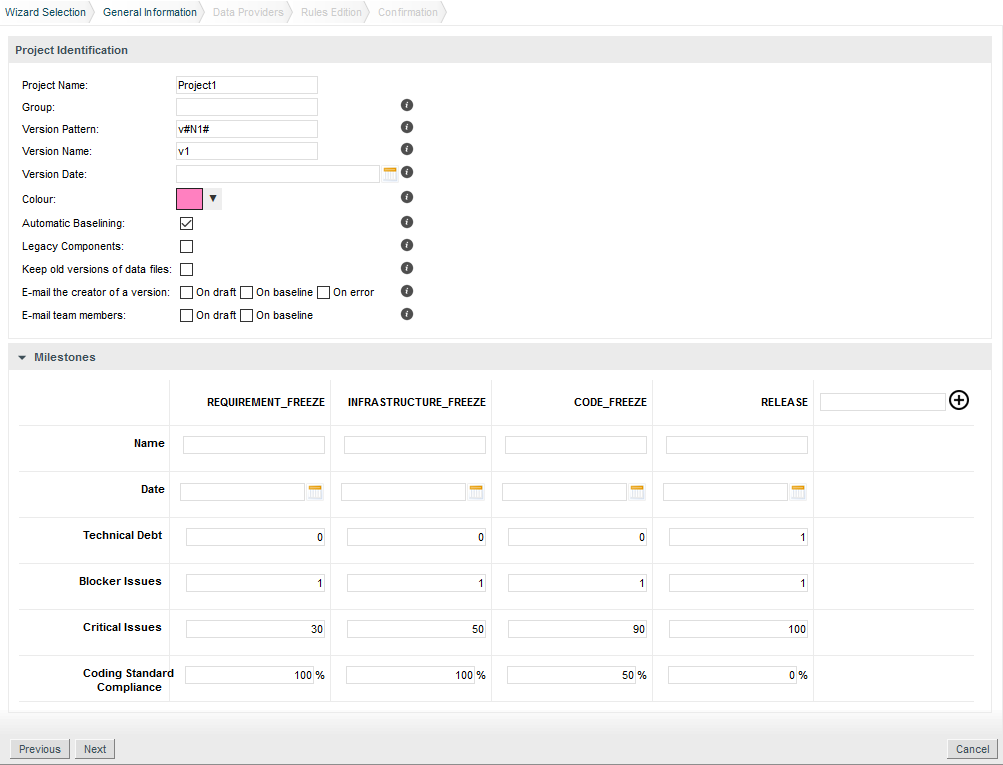
A project wizard with preconfigured milestones and goals
If you create projects using the command line interface, you can specify settings for your milestones with the -M parameter:
-M "id=BETA_RELEASE,date=2017/05/31,ISSUE_CRITICAL=95"
or with a project config file:
<SquoreProjectSettings> <Wizard> <Milestones> <Milestone id="BETA_RELEASE" date="2017-05-31"> <Goal id="ISSUE_CRITICAL" value="95" /> </Milestone> </Milestones> </Wizard> </SquoreProjectSettings>
In your analysis model, new functions are available to work with milestones and projections:
HAS_MILESTONE([milestoneId or keyword] [, date])
checks if
a milestone with the specified milestoneId exists in the project.
The function returns 0 if no milestone is found, 1 if a milestone is found.
DATE_MILESTONE([milestoneId or keyword] [, date])
returns the date associated to a milestone.
GOAL(measureId [, milestoneId or keyword] [, date])
returns the goal for a metric at a milestone.
You can use keywords instead of using a milestone ID. You can retrieve information about the next, previous, first or last milestones in the project by using:
NEXT
NEXT+STEP
where STEP is a number indicating how many milestones to jump ahead
PREVIOUS
PREVIOUS-STEP
where STEP is a number indicating how many milestones to jump backward
FIRST
LAST
Consut the Configuration Guide for more details.
On your charts, you are now able to:
Display the goals defined for each milestone in your project
Display the changes made to the goals defined for each milestone
Display the date changes for your milestones
Show markers for milestone dates and goals
You can also compute metrics with functions like LEAST_SQUARE_FIT(), which lets you calculate projections. This is how the Task Completion chart used in this example was created. You can find its full definition below:
<chart id="OBJECTIVE_TECH_DEBT" type="TE" byTime="true" dateFormat="MM/yy" yMin="0" displayOnlyIf="HAD_GOAL_TECH_DEBT"> <dataset renderer="LINE"> <measure dataBounds="[0;[" color="#0B3861" stroke="SOLID" shape="CIRCLE" alpha="200" label="Actual">TECH_DEBT</measure> <measure color="#0B3861" stroke="DOTTED" shape="CIRCLE" alpha="200" label="Projected">TECH_DEBT <forecast> <estimatedVersion timeValue="CUR_BUILD_DATE+1*DELTA_MEAN"/> <estimatedVersion timeValue="CUR_BUILD_DATE+2*DELTA_MEAN"/> <estimatedVersion timeValue="CUR_BUILD_DATE+3*DELTA_MEAN"/> <estimatedVersion timeValue="CUR_BUILD_DATE+4*DELTA_MEAN"/> <estimatedVersion timeValue="CUR_BUILD_DATE+5*DELTA_MEAN"/> </forecast> </measure> </dataset> <dataset renderer="AREA_STEP"> <goal dataBounds="[0;[" color="88,250,130" stroke="SOLID" shape="DIAMOND" alpha="150" label="Objective Zone">TECH_DEBT</goal> </dataset> <dataset renderer="STEP"> <goal dataBounds="[0;[" color="#31B404" stroke="SOLID" shape="DIAMOND" alpha="255" label="Revised">TECH_DEBT</goal> <goal dataBounds="[0;[" color="#FE2E2E" stroke="DOTTED" shape="CIRCLE" alpha="255" label="Planned" versionDate="FIRST_BUILD_DATE">TECH_DEBT</goal> </dataset> <markers> <marker alpha="150" color="189,189,189" isVertical="false" endValue="0"/> <marker fromMilestones="true" alpha="150" isVertical="true" stroke="DOTTED" /> </markers> </chart>
The action items monitoring the project's progress also make use of the new GOAL() function and were defined as follows:
<?xml version="1.0" encoding="utf-8" standalone="yes"?> <Bundle> <DecisionCriteria> (...) <DecisionCriterion dcId="AI_OBJECTIVE_IN_FUTURE_TECH_DEBT" categories="SCALE_PRIORITY.CRITICAL;SCALE_AI_TYPE.PROCESS_IMPROVEMENT" targetArtefactTypes="APPLICATION"> <Triggers> <Trigger> <Test expr="GOAL_ESTIMATED_TECH_DEBT-ESTIMATED_TECH_DEBT" bounds="];0[" descrId="GOAL_WILL_NOT_BE_REACHED" p0="#{MEASURE.GOAL_ESTIMATED_TECH_DEBT}" p1="#{MEASURE.ESTIMATED_TECH_DEBT}" /> <Test expr="GOAL_TECH_DEBT" bounds="[1;1]" descrId="GOAL_IS_ACTIVATED" p0="#{MEASURE.GOAL_ESTIMATED_TECH_DEBT}" /> <Test expr="DAY_TO_ESTIMATION" bounds="];[" descrId="DAY_TO_ESTIMATION" p0="#{MEASURE.DAY_TO_ESTIMATION}" /> </Trigger> </Triggers> </DecisionCriterion> </DecisionCriteria> </Bundle>
Check out the Getting Started Guide and the Configuration Guide to learn everything about milestones in Squore.